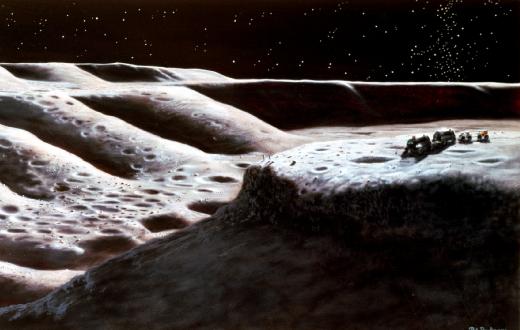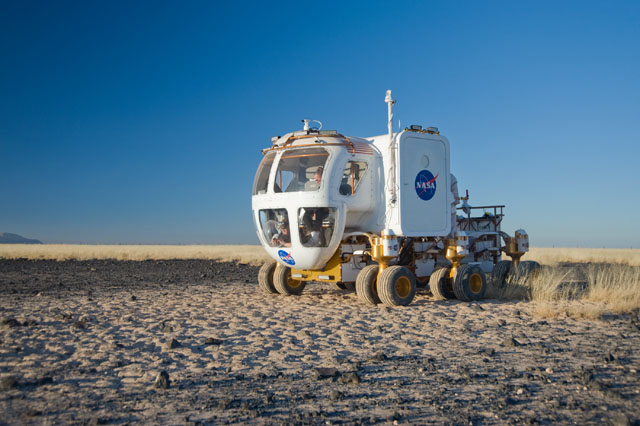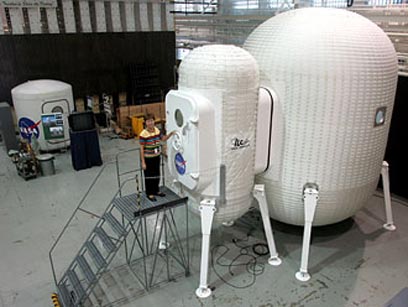NASA intends to send humans to the moon again. Where will they live, and how will they meet their daily needs?

In the book by Arthur C. Clark "2001: A Space Odyssey", and even more so in his and Stanley Kubrick's film, the day-to-day life of an active lunar colony that should have been established some time ago is described. However, politicians apparently did not have this in mind (Nixon, Carter, Reagan), the decline in the US public's interest in science, the results of the war in Vietnam and the ongoing cold war meant that a human foot has not set foot on the lunar surface since the Apollo mission on December 17, 1972 At the last minute, three more Apollo flights were canceled, even though the spacecrafts for them had already been built.
This time the return to the moon will probably be inevitable, unless the current economic crisis overwhelms the decision makers. The reason for this is that competition has begun to emerge from Asian countries - mainly China, but also India - which signal that they intend to send humans to the moon. And as in the sixties of the last century, then there was a fear that those who wanted to reach the moon would have to learn Russian in order to speak with those already staying on its surface. This time the Americans fear that he will be required to learn Chinese, unless the US keeps its word and continues planning the trip to the moon.
In any case, to differentiate the trips to the moon in the 21st century from those of 1972-1969, it seems that this time it will be much longer missions. Therefore, NASA is developing a new generation of equipment that will meet the needs of the new mission: intelligent robots that will assist the astronauts and relieve them of some of the routine or dangerous tasks, lunar vehicles the size of a truck (compared to the small jeeps of the last Apollo missions) that will also contain a compressed passenger compartment , inflatable residences and more.
According to the current forecast, an international operation will be launched to launch individual groups, one at a time, of four crew members who will fly to the moon for a week-long visit until the power supply units, all-terrain vehicles and living quarters are operational. From this point the task will be extended to two weeks, then to two months and eventually to 180 days.
During the first decade of the lunar settlement, the space travelers will learn the techniques and skills required in the end for the journey to Mars. A supply ship will reach them from Earth once every three to four months. The first expeditions included mainly geologists but also construction experts. With the possible increase in the number of people staying on the moon, we may also find doctors.
"If we want to explore the moon for long periods of time, we will have to develop the equipment necessary to survive in this environment," says Frank Peri, director of the technology development program in NASA's manned projects (Exploration Technology Development Program: ETDP) in an interview with Science@nasa.
Unlike the Apollo astronauts who slept in their spaceships, the new residents will have to build homes on the moon that will provide them with protection as no home on Earth provides. First, there is no air on the moon, and the temperature varies from around minus 200 degrees Celsius during the long hours of darkness, to around 120 degrees above zero at the peak of the day. They also have to be careful of micro-meteorites that constantly fall on the lunar surface. The absence of an atmosphere also means that there will be nothing to protect them from the sun's harmful radiation.
Thus, the task of planning a habitation on the moon sounds difficult and complicated. The structure must contain compressed air, so that the astronauts can move around freely inside it and breathe air, and that the structure will not explode or leak. The residential facility must be cooled during the lunar day and heated during the lunar night. It will have to contain a water recycling system, an electricity generation system and means for food storage and preparation.
The materials to build a habitable facility on the moon would have to be light because they would have to be launched from Earth using launchers, and every kilogram counts. The materials on the surface of the moon will not be able to help, at least not at the beginning. It will also be required that the structures reach the moon in parts and be assembled by robots or by the hands of the first astronauts to arrive. They should therefore be designed so that they can be easily assembled, since these people will have to perform the erection task while wearing spacesuits.
This is a huge challenge for NASA and its partners for future explorations, especially now that NASA has announced its intention to build an outpost on the surface of the moon - a camp that will become busy when visitors arrive, but that will also be able to be abandoned for long periods of time without incurring irreparable damage reversible.
Through this outpost, NASA will be able to learn to take advantage of the moon's natural resources that will facilitate life on its surface, help prepare for a trip to Mars, as well as conduct a wide range of scientific research and encourage international partnership. The first step in making the lunar outpost a reality is now being taken, as planners focus their efforts on determining what it will take for humans to live safely on the moon as well as perform useful work.
inflatable structures

One team of experts from the Langley Space Center, the Johnson Space Center in Houston (both of NASA) as well as the NASA subcontractor ILC DOVER, are examining inflatable structures that will be used as building blocks for establishing the base on the moon, or at least as one of the alternatives.
"Inflatable structures can be used as links or tunnels between the living quarters and can also be used as radiation protection facilities, if they are covered with the lunar soil (regolith)," says Chris Moore, director of the technology development department and program manager at NASA headquarters.
As a starting point, the ILC DOVER company sent to NASA's Langley Center an inflatable structure with a diameter of 3.65 meters made of many layers of fabric (made of tubes) for the purpose of on-ground evaluation of technologies that are in development stages such as the state of the 'health' of the flexible structure, self-repairing materials, and materials used for radiation protection. A smaller inflatable structure is also attached to the structure that serves as a demonstration of the air lock. Both structures are compressed cylinders connected by an airtight door.
Dave Cadogan, the company's director of research and development, says that "the habitable structure to be used on other planets and the airlock unit can be used to evaluate materials, lightweight structure technology, interface with the astronauts, dust handling techniques and features related to robots and other equipment that will be used on the surface of the moon. Inflatable buildings are very strong and also adapt to different situations."
Karen Whitley, director of the inflatable buildings project at the Langley Center, explains that "in the next step, the team will carry out a comparative architectural study of inflatable buildings and rigid buildings for the astronauts' residences. The follow-up studies will allow the technology of the inflatable structures to mature, while the design and production of inflatable components on a smaller scale than the planned structures will allow us to conduct more detailed experiments on them."
"For every kilogram of supplies that need to be launched to the moon, 125 kg of equipment and fuel will be required to get it there," says Paul Lockhart, director of the Constellation Systems Program at the Space Exploration Systems Directorate at NASA Headquarters in Washington, adding: "Therefore our concepts of living should be based on lightness and stability. The prototype should be such that you can inflate and deflate it as many times as you want, and the operation of inflating and adapting it to living quarters will only require a few hours of work from a team of four astronauts."
At the beginning of 2007, NASA sent a ship carrying the first inflatable structure to the McMurdo Station in Antarctica. The experiment, which lasted 13 months, started in January 2008 and ended in February 2009. "Experimenting the inflatable structure in one of the most difficult and remote areas on Earth gives us an opportunity to see how we can use it for lunar exploration," says Lockhart. At least the ILC company crowns the experiment as "successful", even though the structure did not last until the end of the experiment.

Air lock
Any structure planned to stand on the moon - and one is whether it will be inflatable or rigid - will need an airlock. The airlock is a small room that connects the door and the outside environment. Both doors must be tightly closed so that not a single drop of air leaks out.
Before the astronauts open the outer door to enter, they must close the inner door. The astronauts will enter the airlock and close the outer door. The air will then be drawn in and fill the room. Only then will the staff members be able to open the inner door and enter the living area.
When they want to leave the residential facility, they will be able to enter - in space suits of course - into the room when the outer door is locked. The inner door will be locked and then the air will be sucked out of the air lock, so that they will remain in a vacuum similar to that outside. Then the astronauts will open the outer door and go outside.
The robot will help
At the time of the Apollo missions, auxiliary robots existed only in science fiction stories. If the astronauts had to move heavy equipment they had to lift it themselves. If they wanted to explore a crater they couldn't send a robot to do a preliminary scan. Semi-autonomous robots developed by ETDP could reduce the risk and provide assistance to astronauts in such missions.
One of the robots that will be able to help lift loads is a six-legged robot called ATHLETE (short for All-Terrain Hex-Limbed Extra-Terrestrial Explorer). "It's actually a big flatbed truck that you can put things on and drive them short distances," Perry says. The robot prototype built by NASA's Jet Propulsion Laboratory (JPL) in California has wheels at the ends of its legs. In this way, he will be able, for example, to drive under the lander, pick it up and move it to another place and thus overcome rocks that might interfere with it. The astronauts will be able to replace one or more wheels with a drill or other tools so that the "athlete" can assist them in other tasks.
When the astronauts want to go out on the lunar surface themselves they will need a better means of transportation than the good old Apollo moon bug. Perry mentions that "if you watched the movies of the Apollo astronauts' trip to the moon, you saw that the trip was quite difficult." If these vehicles were reminiscent of off-road vehicles moving on sand, the new vehicle developed by ETDP will be more reminiscent of a caravan. As mentioned, it will contain a compressed passenger compartment that will also contain several beds so that the astronauts can rest during long research trips.
Bubble-like windows will allow them to view the lunar surface up close without leaving the safe vehicle. If they still want to go out, they will have spacesuits hanging outside the vehicle, and it will be possible to slide into the contents directly from the cabin without the need for an airlock. These suits could allow for longer journeys and would absorb longer periods of exposure to the moon dust. "The original Apollo suits became unusable after only three days when the astronauts wore them," Perry explains, "the new suits will have to survive in this harsh environment for months and years."
Now we can only hope that all these scenarios will not remain on the planning pages, or at best - that they will be translated into Chinese...
Avi Blizovsky is the director of the "Hidan" website, the article was published in the July 2009 issue of "Galileo" magazine
For articles on the subject on the science website

3 תגובות
Whoa whoa whoa
I have no words. Expectation grips us all. On the other hand - we hear about such programs for a long time without "results on the ground".